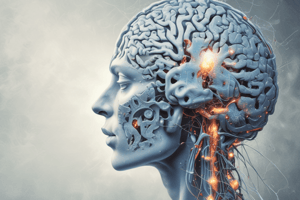Podcast
Questions and Answers
What best distinguishes traumatic brain injury (TBI) from head injury (HI)?
What best distinguishes traumatic brain injury (TBI) from head injury (HI)?
- TBI refers specifically to brain damage, while HI may involve other areas. (correct)
- TBI results from falls, while HI is caused by sports-related impacts.
- TBI is less severe than HI.
- TBI indicates an external force, while HI is internal.
Which of the following is a common cause of closed/non-penetrating TBI?
Which of the following is a common cause of closed/non-penetrating TBI?
- Falling objects
- Penetrating head injuries
- Sports injuries
- Motor vehicle accidents (correct)
What is meant by coup and contrecoup injuries in the context of TBI?
What is meant by coup and contrecoup injuries in the context of TBI?
- Coup refers to delayed symptoms, while contrecoup indicates immediate symptoms.
- Coup injury is caused by external impact, while contrecoup injury affects the brain's opposite pole. (correct)
- Coup injuries are less severe than contrecoup injuries.
- Coup injuries are exclusively found in closed TBI cases.
Which of the following best describes the nature of an external force leading to TBI?
Which of the following best describes the nature of an external force leading to TBI?
What does a closed/non-penetrating brain injury typically result from?
What does a closed/non-penetrating brain injury typically result from?
Which brain mechanism is primarily affected by coup injuries?
Which brain mechanism is primarily affected by coup injuries?
What type of brain injury would most likely result from acceleration-deceleration forces?
What type of brain injury would most likely result from acceleration-deceleration forces?
Which of the following factors does NOT influence recovery after a traumatic brain injury?
Which of the following factors does NOT influence recovery after a traumatic brain injury?
In the context of traumatic brain injury, what does 'functional adaptation' refer to?
In the context of traumatic brain injury, what does 'functional adaptation' refer to?
What is the typical timeframe for spontaneous recovery after a brain injury?
What is the typical timeframe for spontaneous recovery after a brain injury?
What does a higher risk of complications following a traumatic brain injury include?
What does a higher risk of complications following a traumatic brain injury include?
How is mild injury severity defined?
How is mild injury severity defined?
Which of the following is a limitation of the Glasgow coma scale?
Which of the following is a limitation of the Glasgow coma scale?
What does posttraumatic amnesia (PTA) indicate?
What does posttraumatic amnesia (PTA) indicate?
What type of skull fracture is characterized by a distinct, straight line?
What type of skull fracture is characterized by a distinct, straight line?
What is a common result of a traumatic brain injury (TBI) involving acceleration-deceleration forces?
What is a common result of a traumatic brain injury (TBI) involving acceleration-deceleration forces?
Which imaging technique is typically used first to assess traumatic brain injury?
Which imaging technique is typically used first to assess traumatic brain injury?
Which type of degeneration occurs when an axon is torn and degenerates back to the cell body?
Which type of degeneration occurs when an axon is torn and degenerates back to the cell body?
What is one potential result of skull fractures?
What is one potential result of skull fractures?
What defines severe injury severity in traumatic brain injury?
What defines severe injury severity in traumatic brain injury?
In the context of traumatic brain injury, what is the primary vulnerability of the brain?
In the context of traumatic brain injury, what is the primary vulnerability of the brain?
What might a patient experience as a consequence of a traumatic brain injury affecting their emotional regulation?
What might a patient experience as a consequence of a traumatic brain injury affecting their emotional regulation?
What effect does the degeneration of a neuron have on its axon?
What effect does the degeneration of a neuron have on its axon?
What characterizes focal injury in an open/penetrating brain injury?
What characterizes focal injury in an open/penetrating brain injury?
Which aspect of cognitive functioning can be affected by traumatic brain injury?
Which aspect of cognitive functioning can be affected by traumatic brain injury?
What type of injury is classified as open/penetrating brain injury?
What type of injury is classified as open/penetrating brain injury?
What term describes the brain's innate ability to heal after an injury, occurring without external interventions?
What term describes the brain's innate ability to heal after an injury, occurring without external interventions?
Which mechanism involves the loss of function in brain areas that are connected to an injured region, but are not damaged themselves?
Which mechanism involves the loss of function in brain areas that are connected to an injured region, but are not damaged themselves?
What term refers to the formation of new connections between neurons after an injury?
What term refers to the formation of new connections between neurons after an injury?
What occurs when neurons become more responsive to other signals after losing their normal input?
What occurs when neurons become more responsive to other signals after losing their normal input?
Which of the following processes involves the brain's ability to adapt through the creation of new synaptic connections?
Which of the following processes involves the brain's ability to adapt through the creation of new synaptic connections?
What is the term for the process of sprouting new branches from undamaged axons to re-establish connections?
What is the term for the process of sprouting new branches from undamaged axons to re-establish connections?
In which phase does the brain show neurophysiological responses to brain injury, often referred to as 'damage control'?
In which phase does the brain show neurophysiological responses to brain injury, often referred to as 'damage control'?
What function does the phenomenon of diachisis serve during recovery from a brain injury?
What function does the phenomenon of diachisis serve during recovery from a brain injury?
Flashcards are hidden until you start studying
Study Notes
Traumatic Brain Injury (TBI) Overview
- Distinction between head injury (HI) and TBI: HI includes trauma to face, scalp, skull, or brain, while TBI specifically involves disruption of brain function due to external forces.
- TBI is characterized by alteration in brain function and can result from bumps, blows, or penetrating injuries.
Types of TBI
-
Closed/Non-penetrating Injuries
- No penetration of the skull; result from concussive impacts, typically in motor vehicle accidents.
- Brain experiences acceleration, deceleration, and rotational forces.
- Coup Injury: injury at the point of impact.
- Contrecoup Injury: damage at the opposite pole of impact, leading to contusions on frontal and sphenoid plates.
- Common results: diffuse axonal injury, attention deficits, emotional regulation issues, and memory impairments due to axonal damage.
-
Open/Penetrating Injuries
- Involves penetration by a foreign object, leading to localized cerebral pathology.
- Greater risk of complications such as infections, hemorrhages, and seizures.
Measuring Injury Severity
- Severity categorized as mild (~80%), moderate (~10%), or severe (~10%) injuries.
- Severity correlates with functional outcomes through a dose-response relationship.
- Key measures of severity:
- Loss of consciousness (LOC)
- Posttraumatic amnesia (PTA)
- Glasgow Coma Scale (limitations include potential for incorrect assessment)
- Imaging techniques: CT scans initially, MRI for suspected complications.
Primary Injuries and Skull Fractures
- Primary injuries result from the initial trauma and biomechanical forces.
- Skull fractures can lead to infections, cerebrospinal fluid (CSF) leaks, and hematomas; types include:
- Linear Fracture: straight line, relatively benign.
- Acute Phase: immediate neurophysiological response to injury, termed 'damage control'.
Recovery Mechanisms
- Restitution: spontaneous recovery leveraging the brain's innate healing ability, including:
- Diachisis: temporary loss of function in connected but undamaged areas.
- Regeneration: formation of new connections between neurons, limited in the brain compared to the peripheral nervous system (PNS).
- Denervation Supersensitivity: compensatory increase in neuron responsiveness to aid recovery.
Substitution and Functional Adaptation
- Brain exhibits plasticity and redundancy, adapting to losses through functional compensation.
- Specific areas of the brain affected correlate with particular functional deficits, such as:
- Prefrontal Cortex: executive function issues.
- Posterior Parietal: sensory loss affecting visual processing.
- Temporal Lobe: memory disturbances due to contrecoup injuries.
- Factors influencing recovery: time since injury, injury severity, familial support, access to resources, and the effectiveness of intervention strategies.
- Spontaneous recovery may occur from 6 months to 2 years post-injury.
Rehabilitation Strategies
- Employ strategies like checklists and memory aids to support recovery.
- Interventions should consider the individual's context for enhanced outcomes.
Studying That Suits You
Use AI to generate personalized quizzes and flashcards to suit your learning preferences.




